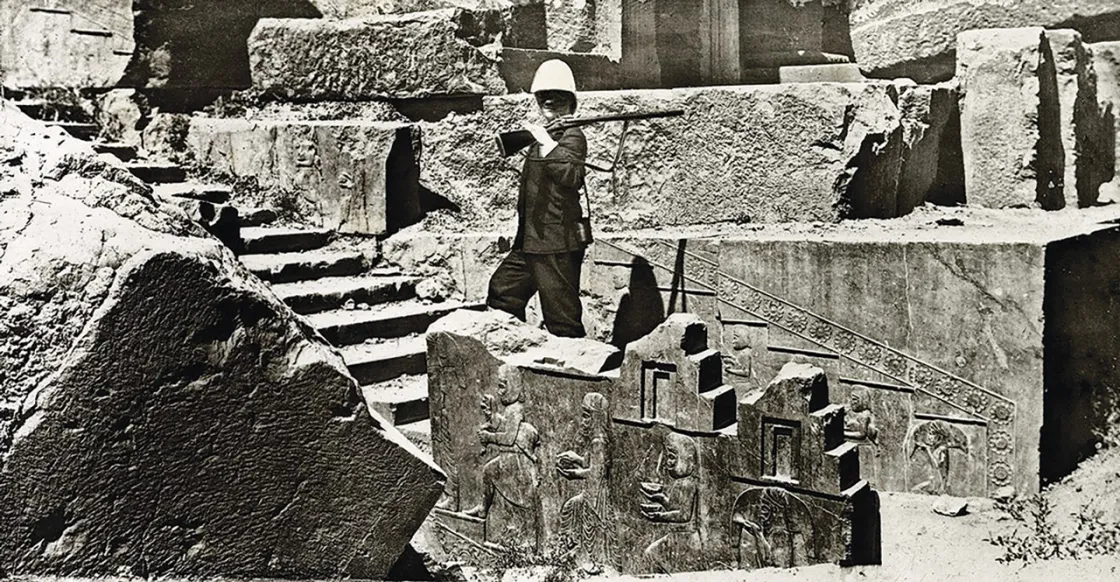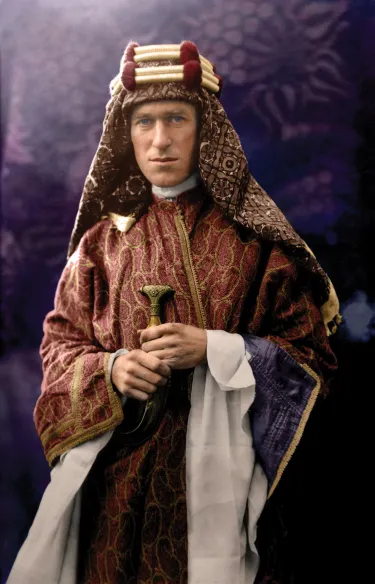Archaeology & The Military: A Long Tradition

Those who have worn a uniform have been excavating historic sites for centuries.
Illustration of an inherent connection or natural intersection between the military and archaeology run far deeper than the recent resonance and success of AVAR. In fact, many of the most famous archaeologists in history have had military backgrounds themselves, placing AVAR teams in a grand tradition. Roque Joaquin de Alcubierre was a military engineer and, ultimately, a field marshall in the Spanish army, who spent part of his career in Italy. There, while digging the foundation for a new palace on the estate of the King of Naples (later, King Charles III of Spain), he uncovered remains of the Roman city of Herculaneum in 1738. Working under the monarch's eager patronage, Alcubierre went on to uncover Pompeii itself.
Augustus Henry Lane-Fox ( who later adopted the surname Pitt Rivers, after inheriting vast estates from a relative, the sixth Baron Rivers) served more than three decades in the British Army, principally the Grenadier Guards, and showed notable bravery on the front lines of the Battle of Alma during the Crimean War. He ultimately retired with the honorary rank of lieutenant general in recognition of his role in adopting widespread use of the smoothbore musket and refining its practice. He had become interested in archaeology during military postings overseas and his inherited wealth allowed him to pursue the passion with vigor becoming noted for his specialized knowledge of the development of weaponry. While still serving in the military he amassed a collection so vast that its donation to Oxford – some 20,000 artifacts – necessitated the creation of the Pitt Rivers Museum, still a treasure of the university. After leaving the army, and recognizing that his own property was likely to hold a wealth of Roman and Saxon materials, he spent 17 seasons excavating his own lands, instituting the most methodical standards for recordation to date, insisting that all artifacts and not just the beautiful or rare ones be catalogued, leading to far deeper understanding of everyday life in past periods.
Meanwhile on the continent, Eduard von Kallee rose through the ranks to become a major general in the army of the Kingdom of Wiirttemberg, prior to the unification of the German states, commanding troops in several battles of the Austro-Prussian War. After 1869, he used skills honed in the military to assess the potential strategic significance of locations and deem whether they would be worthy of excavation. As a result, he explored a series of Roman limes, the frontier forts that marked the farthest reaches of that vast empire, which are now recognized as a UNESCO World Heritage Site.
Charles Warren, a lieutenant general of the British Royal Engineers, was an early archaeologist of the Holy Land, particularly Temple Mount and the site of the biblical city of Jericho. He commanded troops in South Africa during the Transkei War (1877-1878) and the Second Boer War ( 1899-1902), spending stints in the interim as chief instructor in surveying at the Royal School of Military Engineering, commander of the garrison in Singapore and commissioner of police of the metropolis in London during the Jack the Ripper investigation. In retirement, he was instrumental in the foundation of the Boy Scouts.

When the Franco-Prussian War broke out in 1870, the same year that she married her husband Marcel, Jane Dieulafoy chose to disguise herself as a man and accompany him to the front lines. When the war ended, the Dieulafoys began to travel abroad on archaeological quests to Egypt, Morocco and Persia; ultimately, two rooms at the Louvre would be devoted to artifacts uncovered by the pair. She died in 1916, after contracting amoebic dysentery while in Morocco on behalf of the French government during World War I, having actively campaigned for greater women's involvement in the war effort.

T.E. Lawrence found fascination with archaeology as a teenager, monitoring local building sites and turning over any artifacts to the Ashmolean Museum at Oxford, which made note of its youthful contributor in its annual report. After graduating Jesus College, Oxford, with First Class Honors, that museum's director secured Lawrence a place on a British Museum expedition in Lebanon and Syria, where he met Leonard Woolley. The two men were used on several occasions as archaeological smokescreens for British intelligence operations, surreptitiously mapping strategic areas and observing infrastructure construction. Upon enlisting in the British army at the outset of World War I, they were assigned to the Arab Bureau intelligence unit in Cairo. It was from this station that Lawrence became the legendary figure of the Great Arab Revolt against the Ottoman Empire in 1916-1917, "Lawrence of Arabia:' Woolley, however, was captured by Turkish forces while on a naval intelligence mission and spent two years as a POW. After the war, he returned to excavating, later publishing a theory that the biblical flood of Noah was a historical event centered around the Sumerian city-state of Ur, having found a flood stratum 400 miles long and 100 miles wide. Decades later, he returned to military service as a lieutenant colonel in the Allied Monuments, Fine Arts, and Archives program during World War II.
Even before OSG Crawford saw action on the western front with the London Scottish Regiment, he had been on expeditions to digs in Egypt and Sudan. After recovering from influenza and malaria contracted in the trenches, he was commissioned a maps officer in the Royal Berkshire Regiment before his successful application to the Royal Flying Corps, drawing maps and taking pictures while air born. He was wounded on his maiden flight and later shot down, spending the final eight months of the war at a German prison camp. After the Armistice, he began a long career mapping for the Ordinance Survey and, thanks to his wartime work, became an advocate for the new field of aerial archaeology.
If William Campbell had not been exposed to mustard gas in Europe just two days before the 1918 Armistice, it is unlikely that he and wife Elizabeth Warder Crozer Campbell would have sought out the dry desert air of California, but their work in that location made the first use of environmental archaeology, positing that the geologic features associated with artifacts could be used in dating the period of significance. Anatomist and anthropologist Raymond Arthur Dart served medic in the Australian Army, but is best known for his involvement in the 1924 discovery of Australopithecus africanus which represented a "missing link" in human evolution. Ovid Sellers served as a chaplain in the American Expeditionary Forces decades before, as an Old Testament languages expert, he was a central figure in the discovery of the Dead Sea Scrolls.
Mortimer Wheeler rose through the ranks of the Royal Field Artillery to become a major, even receiving the Military Cross for his heroics. Between the wars, he rose to prominence in the field of archaeology, with positions at the National Museum of Wales, London Museum and the Institute of Archaeology. Unlike many of his fellow academics, who served in various intelligence capacities during World War II, Wheeler volunteered for active duty in the artillery, serving in the North African Campaign and helping plan the invasion of Italy. In several instances, he successfully lobbied that military plans be adapted to protect antiquities.
Dorothy Garrod, meanwhile, earned a degree in history from Newnham College, Cambridge, at a time when few women attended university. From 1938 to 1952, she was the Disney Professor of Archaeology at the University of Cambridge and the first woman to hold an Oxbridge chair, although she took a leave of absence from 1941 to 1947 to serve in the Women's Auxiliary Air Force, working in photographic intelligence.
In fact, the Royal Air Force (RAF) base at Medmenham had an entire group specializing in aerial reconnaissance, populated with exceptional archaeologists, whose meticulous skill in picking out minute details from a broader picture made them perfect for the job. Other members included: Grahame Clark, who, despite the paper rationing and the inability of members of the Prehistoric Society to conduct field research, kept the group's journal in publication; Glyn Daniel, who later became a public face for archaeology, popularizing the field as a television presenter; and Stuart Piggott, who, when assigned to re-create Medmenham's success at a station in Delhi, developed expertise in archaeology on the subcontinent in his spare time.
After meeting during service in the Royal Air Force and upon discovering a mutual interest in archaeology, Ernest Greenfield and Philip Rahtz became fast friends. They encouraged each other to pursue the field professionally and went on to successful careers excavating important sites around Britain, including the Great Whitcomb Roman Villa, Glastonbury Tor and Old Sarum, the first settlement at Salisbury. Philip Barker, another RAF veteran, also found archaeology after the war. He went on to write the comprehensive guide to field technique and excavation methodology, and founded the Institute of Field Archaeologists.
Another unit that drew academic heavyweights from around the globe was the Monuments, Fine Arts, and Archives program under the Civil Affairs and Military Government Sections of the Allied armies – more commonly known today as the "Monuments Men:' Some 400 strong, this group of art historians, architects, museum curators, archaeologists and others with specialized knowledge s worked to safeguard historic and cultural treasures and, as the war drew to a close, recover and repatriate items that had been stolen or hidden. For example, when the Allies prepared to take Florence, which served as Nazi distribution center, MFAA personnel annotated aerial photographs so that cultural treasures would be avoided.





